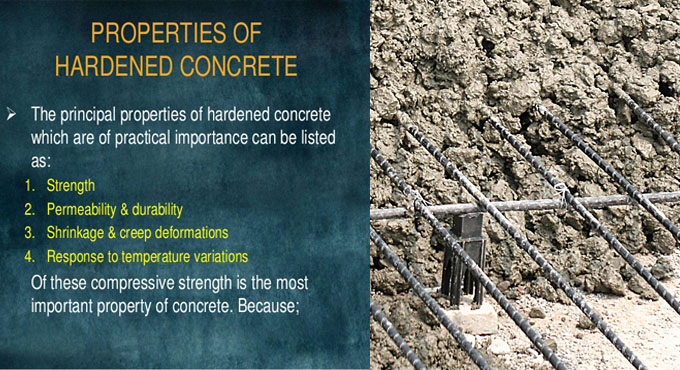
Some vital characteristics of concrete in fresh and hardened state

STRENGTH:
Concrete has good strength against compression but poor strength against tension and bending as a result the concrete can?t be demolished easily but with little force, it can be separated into pieces or leads to bending cracks.
Compressive strength is mainly based on the amount of cement utilized, but it is also influenced by the ratio of water to cement along with proper mixing and placing, and the capacity and extent of hydration and curing.
Both tensile strength and flexural bending strength will be raised with inclusion of steel or fiber reinforcement.
Desired compressive strength is based on an analysis of the loads that will be applied and the soil conditions at the project site.
DURABILITY
Concrete that will be walked or driven on should have good resistance capacity against abrasion in order that it doesn?t corrode.
Concrete that is uncovered to the exterior of a building should contain strong resistance capacity against weather in order that it doesn?t weaken from frequent freezing and thawing.
The stability of concrete uncovered to frequent freeze-thaw cycles is considerably raised with air entrainment.
Concrete in which steel reinforcement is implanted should control extra moisture absorption with the purpose of safeguarding the metal from corrosion.
VOLUME STABILITY:
As a porous material, the concrete is widened and compacted with variations in temperature and moisture content. Preliminary shrinkage occurs to cement-based products like concrete, concrete masonry and stucco since the cement hydrates and additional mixing water evaporates.
Additional shrinkage in concrete leads to cracking and consequently facilitate the moisture to infiltrate, and a vicious cycle of corrosion will start.
Shrinkage cracking is controlled moderately with steel or fiber reinforcement, and the position and weather resistance of shrinkage cracks can also be controlled via control joints which segregate the concrete into smaller panels or sections.
The shrinkage cracking may also be affected with the mix design and ingredient proportions.
WORKABILITY:
The workability of fresh concrete becomes superior when it is formed, compacted, and finished to its final shape and texture with nominal attempt and devoid of segregation of the materials.
Due to poor workability, the concrete fails to flow smoothly into forms and correctly envelop reinforcing steel and embedded items, and it becomes complicated to compact and finish.
Every mix should be perfect for its proposed application, maintaining a balance between desired fluidity, strength, and economy.
Workability is associated with the stability and cohesiveness of the mix, and is influenced by the cement content, aggregates, water content, and admixtures.
CONSISTENCY:
Consistency is an attribute of workability concerning the flow characteristics of fresh concrete.
It is the evidence of the fluidity or wetness of a mix and is calculated with the slump test. Fresh concrete is set in a metal cone and after detaching the cone, the concrete slumps a certain amount based on fluidity. A wet, soft mix slumps in a greater extent as compared to a drier, stiffer one.
A high-slump mix leads to extra bleeding, shrinkage, cracking, and dusting of the hardened concrete surface.
A specific range of consistency exists that is ideal for each type of work. Workability is highest in concrete having medium consistency with a slump among 3 and 6 in. The functionality of both very dry (low-slump) and very wet (high-slump) mixes is reduced.
COHESIVENESS:
Cohesiveness refers to the component of workability to identify whether a mix is harsh, sticky, or plastic.
A harsh mix does not have plasticity and the elements may have a propensity to detach.
Harshness occurs due to extra or shortage of mixing water (high- or low-slump mixes), a shortage of cement (lean mixes), or fine aggregate particles.
Harshness may also occur because of extra rough, angular, flat, or elongated aggregate particles. Harsh mixes are improved with air entrainment or by enhancing the fine aggregate or cement content, but modifications should be done to the overall mix to sustain the exact proportion of all materials.
A sticky mix may contain higher cement content (fat mixes) or large amounts of rock dust, fine sand, or similar fine materials (over-sanded mixes). Sticky mixes are not detached easily, but as they need a lot of water to attain nominal workability, sticky mixes may frequently contribute to extra shrinkage cracking.
A plastic mix is cohesive without becoming either sticky or harsh, and the materials can be easily detached until the concrete is managed incorrectly.


